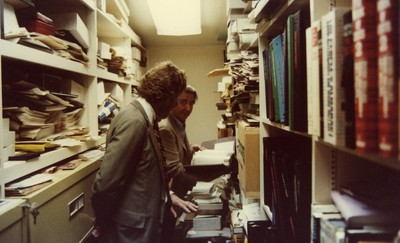rving Wallace (1916-1990) was one of the most widely read novelists of his time. A one-time Hollywood screenwriter, Wallace had a knack for delivering stories with mass appeal. Blending workmanlike prose with meticulous research and can’t-put-it-down plots, Wallace won legions of fans worldwide with titles like The Chapman Report (1961), The Prize (1962), The Man (1964), and The Word (1972). By the time of his death in 1990, Wallace’s books had sold roughly 200 million copies, making him one of the best-selling writers of the twentieth century.
Wallace’s papers first came to Claremont in 1982, in a move that drew the bemused attention of observers. The Los Angeles Times called Honnold Library’s acquisition of the Wallace materials an “odd academic marriage.” What use, the paper asked, did the Claremont Colleges–“a bastion of the intellectually elite”–have for the papers of this “hero-novelist of the reading masses, a man about whose books critics sometimes trot out words such as trashy and vulgar?” To be sure, Wallace never enjoyed great acclaim from critics in his lifetime, and scholarly attention for his work has been minimal since his death. The Times‘s question was a fair one.
It so happened that the library saw the Wallace papers as a test case for its new computer, known as the Claremont Total Library System. The system, one of the first of its kind in the country, enabled electronic searching of Wallace’s prodigious materials. However unlikely the match between Wallace and the Honnold Library was, the sheer size of the Wallace collection presented the library with a unique opportunity to make use of its new technology–or to Wallace, “this damn computer.”

Today, the Wallace collection bears the marks of its early history as a guinea pig for new technology. In order to make Wallace’s papers searchable on the fledgling electronic platform, archivists in the 1980s assigned library-style call numbers to folders of documents. In time, this idiosyncratic system became obsolete, and the Wallace collection is now largely invisible to researchers. Making the collection visible again will require a good deal of reprocessing following standard archival practices. Given that the Wallace collection fills an entire room in the basement of Honnold Mudd Library, the process is sure to be a long but rewarding one.
I look forward to sharing my thoughts about this process in the weeks and months ahead.
Sources:
Beverly Beyette, “Odd Academic Marriage at Claremont Colleges,” Los Angeles Times, March 24, 1983.
Burt A. Folkart, “Irving Wallace; Prolific Writer Reached Billion Readers,” Los Angeles Times, June 30, 1990.